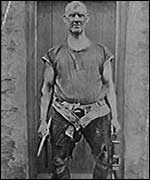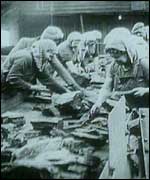|
At its peak in 1913, the Great North Coalfield employed almost ¼ million men, producing over 56 million tons of coal every year from about 400 pits.
The North East produced a quarter of Britain's coal in 1913, and was heavily dependent on 'carboniferous capitalism'.
A Dangerous Profession
 |
|
A Stanley miner wearing hoggers and carrying a safety lamp |
Mining was a dangerous profession with terrible working conditions
especially in the early 19th century.
In the early days the miners used hand picks, and conditions
were cramped with little health and safety provision.
There were hazards and dangers everywhere from explosions,
fires, and roof falls, to suffocating gases and flood ing.
Miners laboured in cramped conditions and some like the one in the photograph opposite developed bandy legs.
There were many disasters such as the West Stanley pit disaster in 1909 in which 160 men were killed. The whole mine shook from two devastating blasts caused by illegal lamps. The funerals of the victims was terrible with many of the men being buried in trenches. 59 of the victims were under 20 years of age. Their families received minimal compensation.
During the 1920s there were several miners' strikes. In 1926 the miners were starved back to work. Pit owners controlled many of the colliery houses and during times of strike they employed 'candymen' to put the families of striking miners out onto the streets.
Conditions improved with nationalisation in 1947, but many miners continued to suffer from health problems such as lung conditions.
Pit Villages
 |
|
Women mining workers sorting the coal |
Many towns such as Seaham Harbour, Easington Village, Bedlington and Ashington owed their existence to coal, and mining was the focus for the whole community.
Engine houses and their wheels dominated the skylines of the pit villages.
The communities were close-knit with their own social clubs, community facilities and brass bands.
A common sight were the pit cottages. Pits were often isolated, and the homes were built near them.
A typical collier's cottage consisted of two to four rooms and sometimes had a pitman's garden nearby.
Coal was moved from the pithead by railway. Many collieries had their own systems with lines connecting to the main rail network.
Miners at play
The miners' galas were a great social occasion, and a chance for the workers to enjoy a day out with their families. They met everyone from the surrounding villages, many of whom they only saw once a year.
 |
|
A day out at the Bedlington Miners Picnic in 1960 |
The biggest of all was the Durham Miners' Gala which has become a national institution, and is still an important date in the North's calendar.
Watch miners enjoying a day out a the Gala in the film "Like A Candyman's Trumpet" which also features scenes of miners relaxing with their families at Durham Racecourse.
Join the Bedlington Miners' Picnic in 1960 in a remarkable film made by Ken Russell. Join Pegswood Brass Band as it tunes up and rehearses for its big day, and competes with bands from neighbouring villages.
Looking Back
Today the coal mining industry is almost extinct in the North with only a handful of pits still producing what was once called 'the black diamond'.
The archive clips provide a glimpse of an industry that once was the power house of the North.
|

